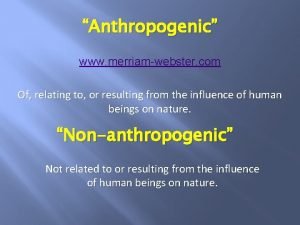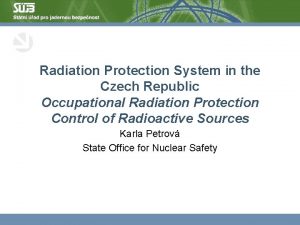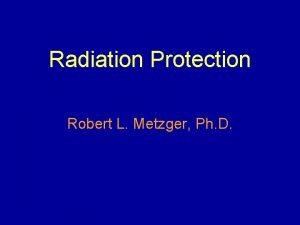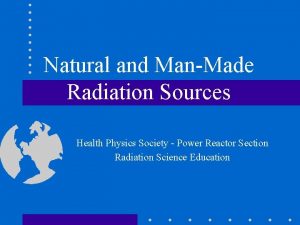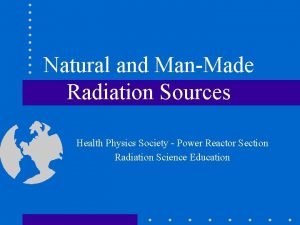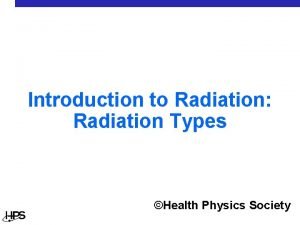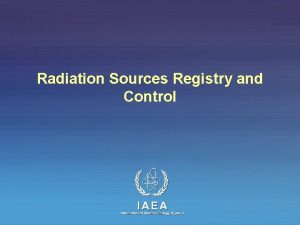Natural and ManMade Radiation Sources Health Physics Society











- Slides: 11

Natural and Man-Made Radiation Sources Health Physics Society - Power Reactor Section Radiation Science Education

Introduction • Scientists have studied radiation for over 100 years and we know a great deal about it. • Radiation is part of nature. All living creatures, from the beginning of time, have been, and are still being, exposed to radiation. • Sources of radiation can be divided into two categories: • Natural Background Radiation • Man-Made Radiation

Natural Background Radiation • Cosmic Radiation • Terrestrial Radiation • Internal Radiation

Cosmic Radiation • The earth, and all living things on it, are constantly bombarded by radiation from outer space, similar to a steady drizzle of rain. • Charged particles from the sun and stars interact with the earth’s atmosphere and magnetic field to produce a shower of radiation. • The amount of cosmic radiation varies in different parts of the world due to differences in elevation and to the effects of the earth’s magnetic field.

Terrestrial Radiation • Radioactive material is also found throughout nature in soil, water, and vegetation. • Important radioactive elements include uranium and thorium and their radioactive decay products which have been present since the earth was formed billions of years ago. • Some radioactive material is ingested with food and water. Radon gas, a radioactive decay product of uranium is inhaled. • The amount of terrestrial radiation varies in different parts of the world due to different concentrations of uranium and thorium in soil.

Internal Radiation • People are exposed to radiation from radioactive material inside their bodies. Besides radon, the most important internal radioactive element is naturally occurring potassium-40 but uranium and thorium are also present. • The amount of radiation from potassium-40 does not vary much from one person to another. However, exposure from radon varies significantly from place to place depending on the amount of uranium in the soil. • On average, in the United States radon contributes 55% or all radiation exposure from natural and man-made sources. Another 11% comes from the other radioactive materials inside the body.

Man-Made Radiation Sources • The Nuclear Regulatory Commission and other federal and state agencies regulate exposure from man-made radiation sources. Different regulations apply to two distinct groups: – Members of the public – Occupational workers

Sources of Exposure • Examples of man-made sources of radiation to members of the public: • Student activity: Guess which sources contribute the most to man -made radiation exposure: – Natural gas – (1) – Lantern mantles – (2) – Medical diagnosis – (3) – Building materials – (4) – Nuclear power plants – (5) – Coal power plants – (6) – Tobacco – (7) – Phosphate fertilizers – (8)

Annual Average Dose (mrem/year) man-made source

How Radiation is Used • Science – carbon dating to determine age – instruments to measure density – power satellites • Medicine – x-rays and nuclear medicine – diagnose and treat illness • Industry – smoke detectors – kill bacteria and preserve food

Radiation in Medicine • Radiation used in medicine is the largest source of man-made radiation. • Most of our exposure is from diagnostic x-rays.





